| Author |
 Topic Topic  |
|
captaindarkangel
New Member

USA
17 Posts |
Posted - 01/14/2010 : 05:10:29


|
wow lots of history in this thread!
and alot of nice coins too! its
like a cliff hanger not knowing
what your gonna show next lol |
 |
 |
|
|
uthminsta
1000+ Penny Miser Member
    
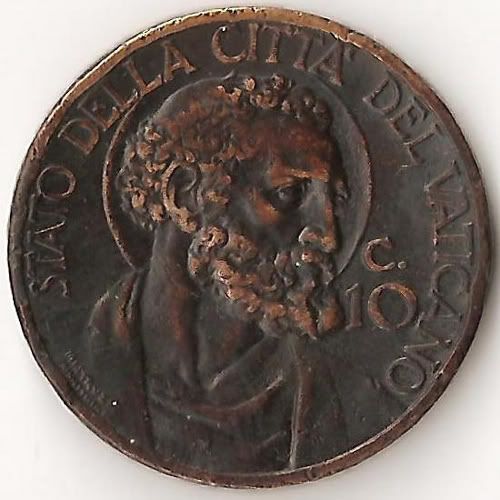
USA
1872 Posts |
 Posted - 01/14/2010 : 22:13:00 Posted - 01/14/2010 : 22:13:00


|
Great Britain series, day 10:
VICTORIA, gothic and jubilee designs - SILVER ONLY.


Today we see two silver-only designs for Victoria; I know they don't qualify as "Beautiful Bronze" but I felt the series would be incomplete without them. And besides, all you silver fans can have your day!
The Gothic design was used on the crown (not shown) from 1847-53 and on the florin (far left) from 1848-87. These are widely considered some of the most beautiful British silver coins ever minted. I wish my florin did the design justice. :(
The jubilee design was introduced in 1887, to commemorate the 50th anniversary of the ascension of Victoria to the throne. It was continued until 1892 on most coins, and some 1893 sixpence and threepence.
Shown, left to right; gothic florin; jubilee halfcrown, shilling, sixpence, threepence.
Other denominations which included the jubilee design were the crown, double florin, florin.
The switch from copper to bronze coinage in 1860 was accompanied by a large reduction in the weight of those denominations. There was not a corresponding reduction in the weights of the silver coins. They remained the same size and purity (sterling, or 925 fine) until 1920, when the silver was reduced to 500 fine, or 50%.
- I have not read anywhere why these designs were never used on the bronze coins. Anyone with knowledge on the subject, I would LOVE to know! |
Come to the new and improved realcent: http://realcent.org
|
 |
|
|
Junk Woody
Penny Collector Member
  

Canada
262 Posts |
Posted - 01/14/2010 : 23:42:52


|
I think the Gothic Vicky Crown has to be my all time favorite coin.
|
 |
|
|
uthminsta
1000+ Penny Miser Member
    

USA
1872 Posts |
 Posted - 01/15/2010 : 00:10:49 Posted - 01/15/2010 : 00:10:49


|
Check this one out.

Images courtesy of coinsgb.com. Used with permission. |
Come to the new and improved realcent: http://realcent.org
|
 |
|
|
AGgressive Metal
Administrator
    

USA
1937 Posts |
Posted - 01/15/2010 : 00:54:52


|
| You have a good collection going. I just picked up an 1831 British half penny myself. |
And he that hath lyberte ought to kepe hit wel / For nothyng is better than lyberte / For lyberte shold not be wel sold for alle the gold and syluer of all the world.
-Caxton's edition of Aesop's Fables, 1484 |
 |
|
|
uthminsta
1000+ Penny Miser Member
    

USA
1872 Posts |
 Posted - 01/15/2010 : 23:57:44 Posted - 01/15/2010 : 23:57:44


|
Great Britain series, day 11:
VICTORIA old head - 1895-1901

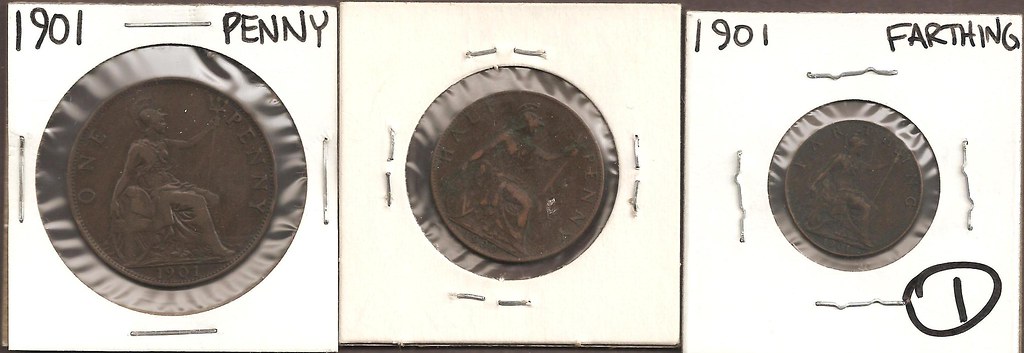
In 1893, with Queen Victoria nearly 74 years old, British silver coinage was redesigned, introducing what has become known as the "old head." The bronze coinage maintained the "young head" through 1894. So the coins shown above represent the bronze coinage of 1895-1901.
Victoria remains the longest-ruling female monarch in history! Should Queen Elizabeth II still be reigning on September 10th, 2015, she would surpass Victoria for that distinction - at the age of 85.
Denominations include the penny, halfpenny, and farthing. Sorry, these are a little dark. |
Come to the new and improved realcent: http://realcent.org
|
Edited by - uthminsta on 01/22/2010 21:17:36 |
 |
|
|
uthminsta
1000+ Penny Miser Member
    

USA
1872 Posts |
 Posted - 01/16/2010 : 20:27:29 Posted - 01/16/2010 : 20:27:29


|
Great Britain series, day 12:
EDWARD VII: 1901-1910.


(images from personal collection)
All 3 coins (from left: penny, halfpenny, farthing) were issued for all 9 years (1902-1910) with very little variation besides the "high tide" and "low tide" varieties in the 1902 penny and halfpenny. In short, the LOW TIDE variety is the good one. See closeups below.
The half farthing (far right) is not a legal tender coin, and I would like to know more about it. There WEREN'T any half farthings issued after 1868, and they ceased to be legal tender after December 31, 1869. There WAS a third farthing however, minted in 1902.
Unofficial variations occurred in the metal composition of the Ed7 bronze coins, resulting in some coins being lighter in color than others. Some are also found with a yellowish streaky appearance. These variations also really affected the way many of the coins toned...
HIGH TIDE........ LOW TIDE
(normal)..........(better)
 
Variety images courtesy of coinsgb.com. Used with permission. |
Come to the new and improved realcent: http://realcent.org
|
Edited by - uthminsta on 01/22/2010 21:18:02 |
 |
|
|
uthminsta
1000+ Penny Miser Member
    

USA
1872 Posts |
 Posted - 01/18/2010 : 11:41:50 Posted - 01/18/2010 : 11:41:50


|
Great Britain series, day 13:
GEORGE V: 1910-1936

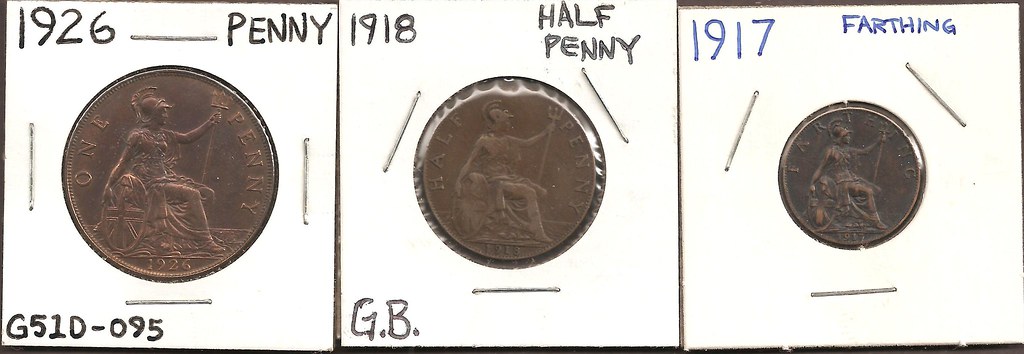
DENOMINATION: Shown are the penny, halfpenny and farthing. The third farthing was also issued (but only in 1913), and this was the last of the subfarthing coins.
APPEARANCE: From 1897-1917, farthings were artificially darkened at the mint to prevent them from being confused with the gold half sovereign. (I wonder if people bought rolls and rolls of farthings and hoped to find a sovereign, just like we do today?)
COMPOSITION: Pennies and farthings were issued with two distinct compositions: 1911-22 was 95% copper, 4% tin, 1% zinc. 1926-36 were minted from 95.5% copper, 3% tin, and 1.5% zinc. This slight change, coupled with slight modifications to the design and relief of the effigy, helped eliminate a problem with ghosting. The halfpenny was the only bronze coin minted from 1923-25, and it is not known when the composition change affected this coin.
VARIETIES: As stated above, there were minor changes to the design and composition, resulting in the "1925 modified effigy" halfpenny and "1926 modified effigy" penny. For a great visual on how to tell the difference, check out: You must be logged in to see this link. |
Come to the new and improved realcent: http://realcent.org
|
Edited by - uthminsta on 01/22/2010 21:18:24 |
 |
|
|
uthminsta
1000+ Penny Miser Member
    

USA
1872 Posts |
Posted - 01/18/2010 : 13:31:45


|
| reached 2000 views! Yay! |
Come to the new and improved realcent: http://realcent.org
|
 |
|
|
uthminsta
1000+ Penny Miser Member
    

USA
1872 Posts |
 Posted - 01/19/2010 : 22:36:22 Posted - 01/19/2010 : 22:36:22


|
Great Britain series, day 14:
EDWARD VIII: 1936-1936

(photo courtesy of wikipedia)
I know, I know, this isn't beautiful bronze; it's BEAUTIFUL BLACK AND WHITE! Today we talk about Edward the Eighth, who chose his wife over the throne. He was made king on January 20th, 1936 and abdicated on December 11th the same year. To read more about this, check out You must be logged in to see this link.
So here's how this plays out in the coins. All the coins of Edward VIII are patterns, because they were still awaiting royal approval when the king abdicated. This short reign brings up two interesting practices in British coinage.
One: Typically the new monarch's coinage begins with the following year, so there are not two monarchs on one year's coins. So even though Edward VIII was king for most of 1936, all coins bearing his image are dated 1937, because the coins of 1936 depicted his father, George V.
Two: It was common practice for consecutive monarchs to face opposite directions. Vic left, Ed7 right, Geo5 left... Ed8 RIGHT. But Edward insisted that this direction was "more flattering" and he wished to discontinue the tradition of opposite facings for successive monarchs. Tomorrow: back to "normal" British coins, where we also see that George VI faced left since he was two monarchs after his father. |
Come to the new and improved realcent: http://realcent.org
|
Edited by - uthminsta on 01/22/2010 21:18:46 |
 |
|
|
uthminsta
1000+ Penny Miser Member
    

USA
1872 Posts |
 Posted - 01/20/2010 : 23:56:15 Posted - 01/20/2010 : 23:56:15


|
Great Britain series, day 15:
GEORGE VI: 1936-1952


George VI was the younger brother of Edward VIII; check out the family resemblance from yesterday's pic!
NEW COIN! The silver threepence was rather tiny, and had become somewhat unpopular. So the brass threepence was introduced in 1937, but both were minted from 1937-44, perhaps because it was unsure whether the new coin would gain popularity. The brass threepence is 79% copper, 20% zinc, and 1% nickel.
NEW DESIGNS: Also shown are the old standbys penny, halfpenny, and farthing. The reverses of the halfpenny and farthing were changed though; the Britannia seated design (which had been used on all copper and bronze coins since the 1600's) was gone, and instead we see a 3-masted sailing ship and a wren.
WARTIME COMPOSITION CHANGES: Pennies dated 1937-40 and post-45 have a composition of 95.5% copper, 3% tin, and 1.5% zinc. Pennies dated 1944-45 have a composition of 97% copper, .5% tin, and 2.5% zinc. There were no pennies dated 1941-43.
EMPEROR OF INDIA: There was only one main obverse design during George VI's reign, but after 1948 the abbreviation IND IMP (Indiae Imperator = Emperor or India) was removed and F. D. was expanded to FIDEI DEF (Fidei Defensor = Defender of the Faith), to make up for some of the deleted wording. check out these closeups:
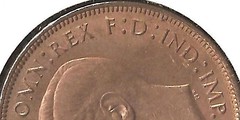  |
Come to the new and improved realcent: http://realcent.org
|
Edited by - uthminsta on 01/22/2010 21:19:02 |
 |
|
|
uthminsta
1000+ Penny Miser Member
    

USA
1872 Posts |
 Posted - 01/21/2010 : 12:55:26 Posted - 01/21/2010 : 12:55:26


|
Great Britain series, day 16:
ELIZABETH II: 1952-present


So we've finally reached the current monarch. This is the first design for Elizabeth II, which was used throughout the 'predecimal' years, 1953-67 and all collector coins dated 1970.
Shown are the brass threepence, penny, halfpenny, and farthing. The farthing was minted until 1956, and was demonetized December 31, 1960.
BRITANNIARUM OMNIUM: The letters BRITT OMN showed on the coins of 1953 only. So it went from DEI GRA (by the grace of God) BRITT OMN (of all the British territories) REGINA (queen)... to... DEI GRATIA REGINA. See below for examples.
Tomorrow: DECIMAL!
 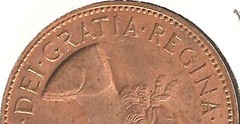 |
Come to the new and improved realcent: http://realcent.org
|
Edited by - uthminsta on 01/22/2010 21:19:23 |
 |
|
|
kirkland
New Member

USA
0 Posts |
Posted - 01/21/2010 : 13:05:40


|
| You all have some pretty cool coins! Thank you for uploading all those pictures, as it is fun to see the coins as well as talk about them. |
 |
|
|
uthminsta
1000+ Penny Miser Member
    

USA
1872 Posts |
 Posted - 01/22/2010 : 17:57:43 Posted - 01/22/2010 : 17:57:43


|
Great Britain series, day 17:
ELIZABETH II decimal coins type 1


Shown are the first design pound, twopence, penny and halfpenny. I included a pound because it is nickel-brass, and the other three of course are bronze. This first design was used from 1968-1984. Here's a timeline of decimal-related events, through 1984.
1967 last circulating coins of the old system
1968 decimal five pence introduced, to circulate alongside the old shilling, with the same value
1968 decimal ten pence introduced, to circulate alongside the old florin, with the same value
1968 1971-dated decimal twopence, penny, and halfpenny introduced in decimal coin sets, although not legal tender until decimal day
1969 old halfpenny withdrawn July 31
1969 decimal fifty pence introduced October 14th; equal to ten shilling note, which was then withdrawn November 1970
1969 old halfcrown withdrawn December 31
1970 collector sets of the "last coins of the old system" bear the 1970 date
1971 banks were closed from February 10 until 10am February 15th to stock up on the new coins
1971 decimal day was February 15th, 1971
1972 commemorative twenty-five pence "crowns" introduced
1982 'NEW' removed from coins: 2 NEW PENCE now said TWO PENCE, etc
1982 twenty pence introduced
1983 pound coin introduced
1984 final halfpenny minted; demonetized in December
For more information about the changeover to the new decimal system, check out You must be logged in to see this link. |
Come to the new and improved realcent: http://realcent.org
|
Edited by - uthminsta on 01/22/2010 21:24:26 |
 |
|
|
uthminsta
1000+ Penny Miser Member
    

USA
1872 Posts |
 Posted - 01/23/2010 : 11:16:50 Posted - 01/23/2010 : 11:16:50


|
Great Britain series, day 18:
ELIZABETH II decimal coins type 2


Shown here are the two pound, pound, twopence, and penny. This design was used from 1985-1997, and marks the last of the British bronze issues, as the coins were switched over to copper plated steel in 1992. To be exact, the 1992 twopence and pennies in proof and uncirculated sets are bronze, while the circulation strikes are copper plated steel. In interest of continuity, I will show the final (current) design of British coins tomorrow, even though technically they wouldn't be beautiful bronze.
Decimal timeline, continued.
1985 design 2 introduced, bigger crown (as shown above)
1986 two pound (nickel-brass) coin introduced
1990 five pound coin introduced
1990 five pence reduced, larger coins progressively withdrawn
1992 ten pence reduced, larger coins progressively withdrawn
1992 twopence and penny composition changed to copper plated steel
1997 bimetal two pound coin introduced (CuNi center disc, Ni-brass outer ring)
1997 fifty pence reduced, larger coins progressively withdrawn |
Come to the new and improved realcent: http://realcent.org
|
 |
|
|
uthminsta
1000+ Penny Miser Member
    

USA
1872 Posts |
 Posted - 01/24/2010 : 20:28:14 Posted - 01/24/2010 : 20:28:14


|
Great Britain series, day 19 - the final day.
ELIZABETH II decimal coins type 3


Here is the final (current) obverse design of British coins, introduced in 1998. Shown are the bimetallic two pounds, pound, twopence, and penny.
The pound coin has had different reverses each year, portraying different aspects of member nations of the United Kingdom - Scotland, Wales, Northern Ireland, England.
I don't know as much about the last ten years in the coin timeline, but here's what little I know of:
1998 - design 3 introduced, older looking portrait
2009 - "big shield" reverse introduced. All the 2009 "base" coins sort of line up together like a puzzle, to create a large shield design. So this new reverse would count as a new type, but I don't have any of them but the tenpence.
Anyway, there it was. 19 days of different British types. Sooooo... anyone else want to post anything? |
Come to the new and improved realcent: http://realcent.org
|
Edited by - uthminsta on 01/28/2010 00:12:57 |
 |
|
|
uthminsta
1000+ Penny Miser Member
    

USA
1872 Posts |
 Posted - 01/28/2010 : 22:13:16 Posted - 01/28/2010 : 22:13:16


|
I just got this one today and thought wow. This one has to go on "the thread."
Curacao 2.5 cent. Minted in 1944, 1947, 1948. And this little beauty was minted in... Denver!
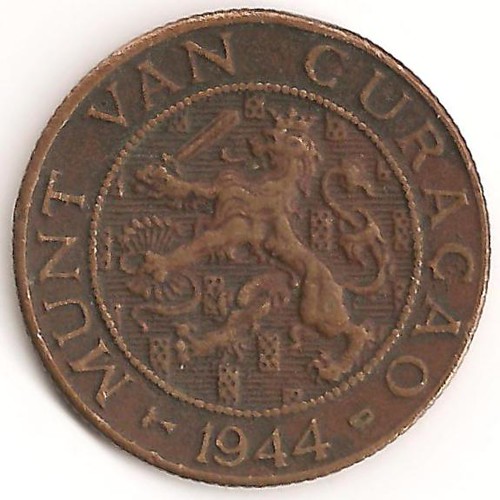 
|
Come to the new and improved realcent: http://realcent.org
|
 |
|
|
uthminsta
1000+ Penny Miser Member
    

USA
1872 Posts |
 Posted - 01/30/2010 : 21:59:36 Posted - 01/30/2010 : 21:59:36


|
some of Ireland's HARPS.
 
Identification of an Irish coin: "Hibernia" is the Latin name for Ireland, which was on 18th & 19th century coins. "Eireann" was used from 1928 until 1937. "Eire" has been used since 1939. The Irish harp is used on all their coins - has been used as a national symbol since the 16th century.
Three distinct eras (a huge oversimplification of the history of Irish coinage):
Sterling until 1969: Pictured are a 1946 penny (bronze) and an 1806 farthing (copper). The farthing shows the King of England because Ireland was under British rule until 1928.
Decimal 1971-1998: shown here are the bronze twopence, penny, halfpenny. All 1971, the first year minted.
Euro2002 to present: representing this era is a 2003 two euro cent (copper plated steel). Yeah, it's not really bronze. Ireland went to the Euro currency in 1999, and began minting Euro coins starting 2002. |
Come to the new and improved realcent: http://realcent.org
|
 |
|
|
aloneibreak
Penny Hoarding Member
   

USA
672 Posts |
Posted - 01/30/2010 : 22:28:23


|
yea for ireland!
ive got one of those hen and chicks pennies i carry for a good luck piece - when i feel i need it
|
My reading of history convinces me that most bad government results from too much government.
Thomas Jefferson
|
 |
|
|
uthminsta
1000+ Penny Miser Member
    

USA
1872 Posts |
 Posted - 01/31/2010 : 16:04:44 Posted - 01/31/2010 : 16:04:44


|
Bermuda one cent. Bronze 1970-91. Copper plated zinc 1991-? Pretty pig!
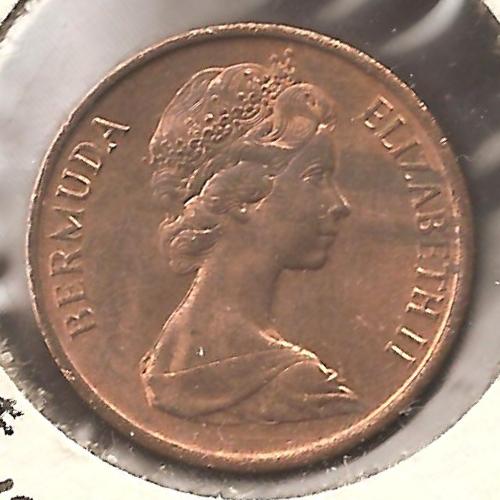 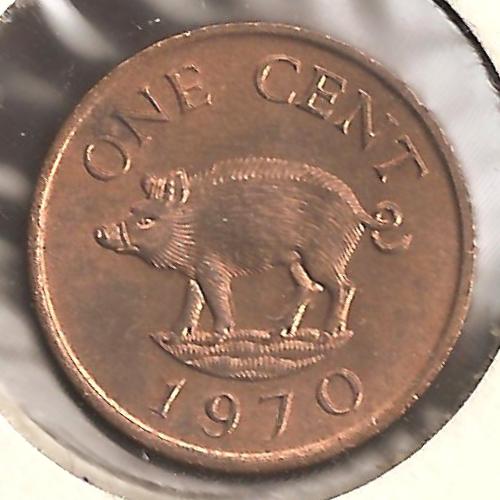
Interestingly, the VERY FIRST coins issued for Bermuda, in the early 17th century, were called HOGGE MONEY because of the pig on the obverse. All local coinage was demonetized in 1842, and UK currency was standard until local coinage was again used starting 1970. Looks like this type is the only easily attainable bronze coinage of Bermuda. |
Come to the new and improved realcent: http://realcent.org
|
Edited by - uthminsta on 01/31/2010 16:06:04 |
 |
|
|
uthminsta
1000+ Penny Miser Member
    

USA
1872 Posts |
 Posted - 02/01/2010 : 17:10:21 Posted - 02/01/2010 : 17:10:21


|
CEYLON (Sri Lanka) one cent.
 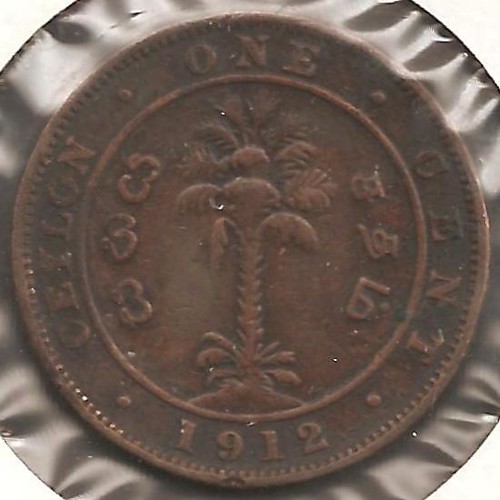
This basic type of cent was copper from 1870-1942 and bronze from 1942-45. Starting in 1963 the cent was a much smaller aluminum coin. Name changed in 1972 from Ceylon to the Republic of Shri Lanka, which means 'resplendent island.' |
Come to the new and improved realcent: http://realcent.org
|
 |
|
|
maoguinn
Penny Pincher Member
 

USA
118 Posts |
Posted - 02/01/2010 : 20:17:53


|
| Those are beautiful coins, uthminsta. I am sorry I don't have anything to share. Maybe it's a good time to start looking. Keep this thread going I am enjoying this. |
 |
|
|
uthminsta
1000+ Penny Miser Member
    

USA
1872 Posts |
 Posted - 02/02/2010 : 23:02:55 Posted - 02/02/2010 : 23:02:55


|
EAST CARIBBEAN TERRITORIES one and two cent.
 
I just thought these were nice because of the portrait. Different than the Liz portraits on the GB stuff. And it doesn't hurt that these are nice red examples. Not a lot of info today... just pretty coins. And I'm tired.  |
Come to the new and improved realcent: http://realcent.org
|
 |
|
|
AGgressive Metal
Administrator
    

USA
1937 Posts |
Posted - 02/02/2010 : 23:49:56


|
| Are those Carribs cleaned or just nice looking? |
And he that hath lyberte ought to kepe hit wel / For nothyng is better than lyberte / For lyberte shold not be wel sold for alle the gold and syluer of all the world.
-Caxton's edition of Aesop's Fables, 1484 |
 |
|
|
uthminsta
1000+ Penny Miser Member
    

USA
1872 Posts |
Posted - 02/03/2010 : 00:20:33


|
| It's always hard to tell for sure, but they came from a collection that was mostly XF-BU. I trust that they are uncleaned. |
Come to the new and improved realcent: http://realcent.org
|
 |
|
 Topic Topic  |
|


